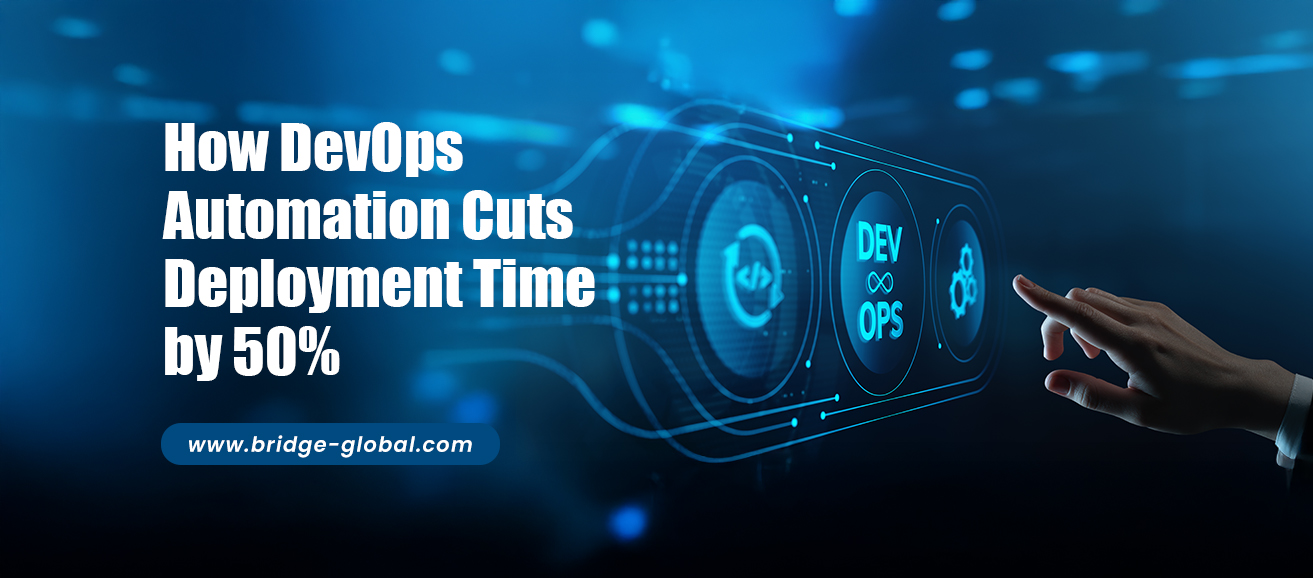DevOps Automation: Cutting Deployment Time by 50%
DevOps automation is redefining how modern software teams deliver value. By integrating automation across development and operations, businesses can accelerate deployment cycles, reduce manual effort, and maintain consistency from code creation to production rollout. In a landscape where agility equals advantage, automation is no longer optional - it’s essential.
Today’s fast-evolving digital ecosystem demands speed, quality, and reliability to coexist. Automating critical stages of the delivery pipeline enables teams to detect issues early, improve collaboration, and deploy updates more frequently without compromising stability or user experience.
For organizations looking to stay ahead, partnering with an experienced software development company or a DevOps consulting partner can unlock measurable efficiency gains. From continuous integration to deployment orchestration, DevOps automation turns software delivery into a competitive differentiator.
The Power of DevOps Automation
At its core, DevOps Automation unifies development and operations into one fluid continuum. Code is continually tested, built, and released via automated pipelines often known as CI/CD integration. A well-engineered pipeline executes test suites, configuration, and deployment without manual intervention, shrinking lead time from weeks to hours. Financial‑tech firms and e‑commerce platforms report deployment time reductions of up to 50%, and in some cases as much as 60%, once automation is mature.
This isn't just about speed; it’s about reliability and consistency. Automated pipelines help avoid “works on my machine” errors by using tools like containerization with Docker and orchestration via Kubernetes to ensure consistent environments. That reliability underlies faster rollbacks and automated roadmaps during failure, thereby improving software resiliency and enhancing developer confidence.
How Cloud-Native DevOps Enables Transformation

Modern transformation leans heavily on cloud-native DevOps, which emphasizes infrastructure scalability and flexibility. Cloud platforms like AWS, Azure, GCP, make it possible to automate complete pipelines end to end. Developers can define infrastructure using code via Infrastructure as Code (IaC) tools such as Terraform or Ansible, enabling fast, repeatable environment provisioning and eliminating manual configuration delays.
True transformation emerges as CI/CD pipelines become cloud‑enabled. With monitoring tools like Prometheus, Grafana, and OpenTelemetry integrated into deployment workflows, teams gain visibility into system performance immediately after release, enabling rapid iteration and continuous improvement.
Integrating DevOps Automation Tools at Scale
Selecting the right DevOps automation tools is crucial. Popular choices include GitLab CI/CD, Azure DevOps Pipelines, Jenkins, CircleCI, GitHub Actions, AWS CodePipeline, ArgoCD, and more. These tools support key features like progressive delivery (canary releases, blue‑green deployments), security scans (SAST/DAST), and policy enforcement.
Rather than building pipelines piecemeal, companies benefit from standardizing toolkits and integration patterns to minimize friction, especially when legacy systems are in play. Toolchain complexity and version conflict are often the largest impediments to reliable automation. Teams overcome this by adopting standardized integration libraries, API-driven communication, and carefully structured templates that reduce dependencies and maximize compatibility.
CI/CD Integration: The Heart of Speed
CI/CD integration lies at the heart of any accelerated delivery strategy. Continuous Integration ensures developer changes are merged frequently and checked via automated tests, while Continuous Deployment or Delivery pushes updates safely into production. When done right with the help of a DevOps services provider, feedback loops become nearly instantaneous, revealing errors early, before they escalate into critical defects .
In cloud-native settings, this feedback loop is accompanied by infrastructure consistency and version control across environments, preventing drift. Automated testing, using both unit and functional test suites executed in parallel, cuts pipeline duration significantly. Combined with IaC, this ensures environments are easily reproducible, secure, and aligned with business requirements.
Navigating Challenges: Architecture and Adoption Barriers

Adopting DevOps Automation is transformational, but it’s not without challenges. A major one emerges when teams attempt to integrate automation with legacy applications or infrastructure that lacks version control or standard pipelines. Modernizing such environments requires careful refactoring or encapsulation in containers to facilitate integration into automated pipelines.
Another barrier is cultural resistance. Development, operations, and QA teams often operate in silos with different toolsets. Implementing DevOps requires a mindset shift - toward shared ownership, upskilling across domains, and cross-functional collaboration. Addressing this requires training, early wins, and leadership support to foster a shared responsibility mindset.
Security is also critical. Accelerating deployment cannot come at the cost of safety. By embedding DevOps automation tools with DevSecOps practices, such as SAST, DAST, dependency scanning, container image checks, and secrets management, teams ensure pipelines remain secure without slowing down delivery. Shifting security “left” has become a core principle of cloud-native DevOps to catch vulnerabilities early and reduce remediation costs.
Scaling Automation with Governance
As pipelines mature, governance becomes vital. Ensuring all components, from CI/CD integration steps to infrastructure provisioning, are compliant, auditable, and repeatable is essential to scale DevOps throughout the enterprise.
Advanced teams build template-driven pipelines with policy gates - automated checks that enforce compliance and thresholds on test coverage or security scan results before deployment continues. Paired with automated rollbacks, blue‑green or canary release techniques, these pipelines provide risk-managed delivery at scale without slowing innovation .
Observability that feeds back into the loop ensures post-deployment performance data informs future cycle improvements. Each deployment generates metrics - deployment duration, rollback frequency, build/test times, that guide incremental optimization efforts.
Partnering with DevOps Consulting or Development Experts
Organizations often call on an AI-powered software development company or specialized DevOps consulting team to accelerate DevOps adoption. These partners bring deep expertise in toolchain integration, infrastructure as code, cloud-native architecture, and the soft skills required to shift culture and process.
Consulting teams guide environments through pilot phases, define governance frameworks, and help select appropriate DevOps automation tools tailored to client infrastructure, complexity, and release cadence. Firms with track records reduce the trial-and-error burden and accelerate value delivery.
From Manual to Automated: The Journey Within
A typical transformation journey starts small - a single service or internal process. Early automation focuses on build/test/deploy for a minimal service. As maturity grows, teams containerize the app, adopt IaC practices, standardize pipelines, and integrate observability. This phased path reduces risk and builds confidence.
As systems scale, additional practices like canary releases, automated rollback, and layered security (DevSecOps) are added. Deployment time shrinks from hours to minutes. Release cadence increases from weekly or monthly to daily or per-feature deployment - transforming how teams operate and innovate.
Business Impact Beyond Speed
Reduced deployment time directly impacts business results. Faster releases mean quicker reaction to customer feedback. Feature iterations become shorter, surveys adapt faster, and A/B test cycles accelerate. Teams deliver business-facing improvements in days instead of weeks.
Reliability improves: automated tests reduce defects, rollbacks minimize disruption, and consistent environments reduce variation. Cost savings emerge from fewer manual operations, reduced human error, and better infrastructure utilization via IaC. Dev teams report improved morale as friction decreases.
From a strategic perspective, organizations with mature DevOps Automation capability gain competitive advantage. They can release faster, iterate more efficiently, and adapt to market demands swiftly - all critical in SaaS, fintech, ecommerce, and modern data-driven sectors.
Future Trends: Integrating DevOps with AI and MLOps
Emerging enterprise patterns combine DevOps with MLOps into unified software pipelines. This integration enables machine learning models to be treated as versioned artifacts, deployed via the same CI/CD pipelines, and governed through unified automation - leading to faster, more reliable AI-driven features in production.
In practice, development teams push updates that trigger both application builds and ML model retraining, validation, and deployment. This approach eliminates silos, improves traceability, and elevates delivery velocity across software and data pipelines.
Closing Thoughts
In enterprises seeking tangible operational transformation, DevOps Automation delivers on its promise. By embedding CI/CD integration, cloud-native infrastructure, and automation tools into daily workflows, teams halve deployment time, boost product quality, and foster a culture of continuous delivery.
To begin this transformation, take a scoped pilot project, engage expert DevOps consulting, adopt proven toolsets, and prioritize training and governance. Combined, these elements drive sustainable acceleration.
With strong governance and cultural alignment, DevOps Automation becomes more than a technical shift - it becomes a competitive advantage. Deployment time shrinks, feature velocity surges, and teams align around continuous improvement.
If reducing deployment duration by 50% or more is a priority, embrace DevOps Automation as your strategic mindset, not just toolchain. The future of software delivery depends on it.



